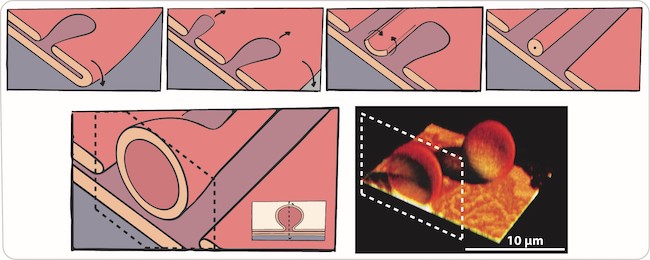The Gözen group’s research explores questions about the origins of life. Since there is no direct evidence of what happened 4 billion years ago, this is an area full of debate on what constitutes the first building block of life.
– We know more about the later stages of evolution, but no one knows how the switch from the soup of non-living things and molecules into the first living organisms occurred, Irep Gözen comments.
The group’s previous study investigated phospholipid molecules that make the cell membrane. For this study the idea was to research the role of fatty acids as they are molecules that are chemically simpler in structure than phospholipids. There is the assumption that since they are more primitive in terms of structure, they must have come first in the evolution of life.
There is also evidence showing that fat molecules could have existed back then, at the beginning of life on Earth. There was a period approximately 4 billion years ago when meteorites were showering the Earth, and we know that meteorites contain these fat molecules as you can still find them in meteorites today. Since fat or lipid molecules constitute the membrane that now surrounds cells today, it is possible to conclude that perhaps this simple material that existed back then, and that is now found everywhere in biology today, could be where all life evolved from.
The role of fatty acids in making the first cells
Inga Põldsalu, the first author of the paper, was the first one to use fatty acids to make the primitive cell networks.
– These fatty acids are simpler in structure, but on the other hand they need much narrower conditions to make these structures. Getting the parameters right was challenging, she says.
Fatty acids are very sensitive to what is around them and so the optimization of the experiments alone took months.
– At first, we tried to just incorporate the simpler fatty acids alone and to some extend succeeded, but the conditions they require are limited. We then discovered that if you mix phospholipids and fatty acids then the conditions needed for this assembly are much broader, so it matters less what is around, Inga explains.
Permeability studies
The other interesting thing was studying permeability to see what could enter into these cell-like compartments.
– The membrane around the cells is to protect them. But at the same time, it has to allow certain things inside. The primitive cell needs both to get useful things inside like genetic material or nutrients, and simultaneously protection from damaging elements i.e. parasitic genetic polymers that would spoil it, Irep explains.
The study therefore looked into what the membrane lets past inside whilst still remaining stable. Usually if the cell lets everything inside, it will also soon disintegrate. However, the group found that if you have a combination of phospholipids and fatty acids mixed together, the cell becomes both: it lets certain things in that it needs, whilst also remaining relatively robust and stable.
– Permeability questions are always relevant for primitive cells because when tools of modern cells which orchestrate traffic in and out of cells today did not exist, the ways cells internalized and maintained ambient components is not straight forward to explain, Irep says.
– Big molecules get in through pores that open for very short time in the membrane, and this is what our study shows.
The study showed that when you apply lipids to surfaces, they form networks and formations. Since nanotubes connect the compartments, if RNA gets into one of them and replicates, it can be sent through these tubes to adjacent compartments.
– Our study shows that if solid surfaces are involved, networks of primitive compartments and bacterial colony like structures form. These structures, if they have fatty acids in their composition, are more likely to be squished together and the proximity makes it possible to distribute genetic material and enhances communication, Inga highlights.
– If you look at bacteria for example, they form colonies. Our results show similar structures which autonomously form, and therefore expand the established spherical compartment model to populations of compartments, Irep adds.
One of the main findings of the study is that by involving both phospholipids and fatty acids, the cell is able to stay stable whilst also allowing in genetic material
– This is the take home message of the work. If these two are mixed they can form stable networks similar to the ones phospholipids do, but they have better permeability to the components that are considered essential for a primitive cell at the origin of life, Irep comments.
Seeing is believing
For Inga the most exciting part of the project was engaging in the imaging process.
– It is so cool to look at these things under the microscope and discover these very unique structures, she says.
– Seeing is believing. We do microscopy. We see directly what we report on. To be able to visualize diverse biomaterial structures is very exciting, Irep concludes.
